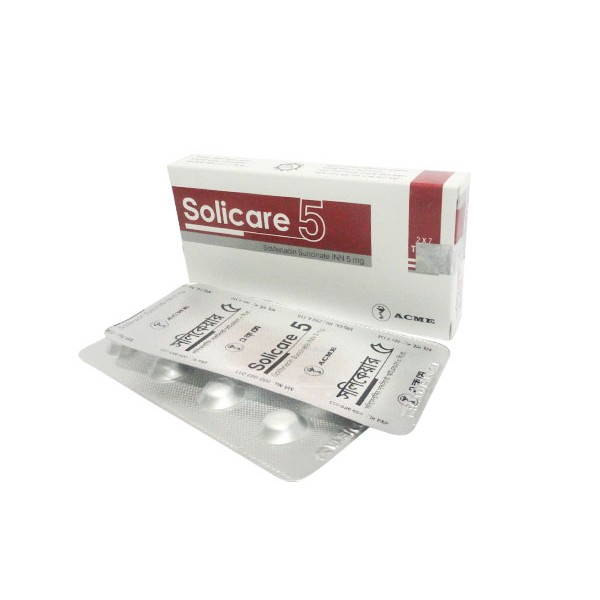
- Stock: In Stock
- Brand: Acme Laboratories Limited
- Product ID: Solifenacin Succinate
100% Secure Payment

Solicare 5 mg Tablet
Indications
Symptomatic treatment of urge incontinence and/or increased urinary frequency and urgency as may occur in patients with overactive bladder syndrome.
Therapeutic Class
Anticholinergics (antimuscarinics)/ Anti-spasmodics, BPH/ Urinary retention/ Urinary incontinence
Pharmacology
Solifenacin is a competitive muscarinic (acetylcholine) receptor antagonist. The binding of acetylcholine to these receptors, particularly the M3 receptor subtype, plays a critical role in the contraction of smooth muscle. By preventing the binding of acetylcholine to these receptors, solifenacin reduces smooth muscle tone in the bladder, allowing the bladder to retain larger volumes of urine and reducing the number of incontinence episodes.
Dosage & Administration
Adults, including the elderly: The recommended dose is Solifenacin Succinate 5 mg once daily. If needed, the dose may be increased to Solifenacin Succinate 10 mg once daily.
Children and adolescents: Safety and effectiveness in children have not yet been established. Therefore, Solifenacin Succinate should not be used in children.
Interaction
Concomitant medication with other drugs with anticholinergic properties may result in more pronounced therapeutic effects and side effects. The therapeutic effect of solifenacin may be reduced by concomitant administration of cholinergic receptor agonists. Solifenacin can reduce the effect of drugs that stimulate the motility of the gastro-intestinal tract, such as metoclopramide and cisapride. Ketoconazole & other CYP3A4 inhibitors increase the plasma concentration of solifenacin.
Contraindications
Solifenacin is contraindicated in patients with hypersensitivity to solifenacin or to any of the excipients. It is also contraindicated in myasthenia gravis, urinary retention, uncontrolled narrow angle glaucoma, severe gastro-intestinal condition (including toxic megacolon), patients undergoing haemodialysis, patients with severe hepatic impairment, patients with severe renal impairment or moderate hepatic impairment and on treatment with a strong CYP3A4 inhibitor, e.g. ketoconazole.
Side Effects
The most common side effects are blurred vision, dry mouth, constipation & heat prostration. Other side effects include dizziness, fatigue, edema, palpitation and skin reactions. Disorientation, hallucination and convulsion may occur.
Pregnancy & Lactation
Use in pregnancy: There are no adequate data from the use of solifenacin succinate in pregnant women. Caution should be exercised while prescribing solifenacin to pregnant women.
Use in lactating mother: No data concerning the excretion of solifenacin into breast milk are available. The use of Solifenacin is avoided in lactating mother.
Precautions
Other causes of frequent urination (heart failure or renal disease) should be assessed before treatment with Solifenacin. If urinary tract infection is present, an appropriate antibacterial therapy should be started. Solifenacin Succinate should be used with caution in patients with clinically significant bladder outflow obstruction at risk of urinary retention, gastrointestinal obstructive disorders, risk of decreased gastrointestinal motility, severe renal impairment (creatinine clearance 30 ml/min), moderate hepatic impairment, concomitant use of a strong CYP3A4 inhibitor, e.g. ketoconazole
Use in Special Population
Patients with renal impairment: No dosage adjustment is necessary for patients with mild to moderate renal impairment (creatinine clearance > 30 ml/min). Patients with severe renal impairment (creatinine clearance 30 ml/min) should be treated with caution and receive no more than 5 mg Solifenacin SuccinateTablet once daily.
Patients with hepatic impairment: No dosage adjustment is necessary for patients with mild hepatic impairment. Patients with moderate hepatic impairment should be treated with caution and receive no more than 5 mg Solifenacin SuccinateTablet once daily.
Patients taking CYP3A4 inhibitors concomitantly: The maximum dose of Solifenacin Succinateshould be limited to 5 mg when treated simultaneously with ketoconazole or other potent CYP3A4 inhibitors e.g. ritonavir, nelfinavir or itraconazole.






























